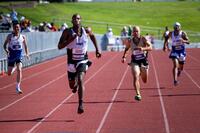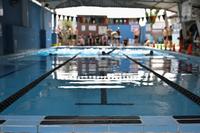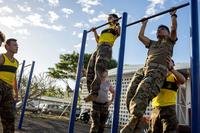I was reminded that I have used my periodization style of training now for 20 years after one of my former Basic Underwater Demolition/SEAL prep students reminded me that it was 20 years ago that he and his classmates shipped off to BUD/S.
That was the year when I learned I needed to make some changes in my personal and profession training program, and they needed to make sense with job requirements. My periodization program is a way to train, not the way to train. It has worked for me from ages 27-47 and took me from a nearly broken, overtrained SEAL officer to a much healthier practitioner of fitness who still can reach spec-ops levels in all elements of fitness.
My Training Kickoff
My history with learning to train, training hard for sports and for the special ops profession has totaled more than 30 years. I received my first weight set from a Sears mail-order catalog for Christmas when I was 13. Since then, I have never stopped training.
Learning from people smarter than me and being guided by high school and college coaches, I cut my teeth in the weight room and powerlifted year-round from ages 14-19. I trained hard year-round to be a better football player and powerlifter.
Gaining weight in my teens was difficult, so I maxed out at about 210 pounds in high school. Then I joined the Navy and was fortunate enough to get accepted into the Naval Academy, where I learned quickly that I was not in military shape. Making the transition from thinking anything more than 100 yards was long distance to a BUD/S candidate, and then a BUD/S graduate by the age of 22, did not come easy.
I trained diligently to make that transition from powerlifter to SEAL candidate. I went to BUD/S at 195 pounds and graduated at a leaner 195.
The Physical Toll
BUD/S is an exercise in how much the human body can take, but you still graduate stronger and harder than when you started. You learn that your body is capable of 10 times what your brain will let you do. Taking that hardcore training philosophy forward for the next several years, staying at the top of what my body could do physically, took its toll.
By the time I was 27, the aches and pains started to show in my back, knees and shoulders. They were mostly soft-tissue issues but also some stress fractures, joint damage and imbalances. This is when I started cycling with different workouts.
Recuperating After BUD/S
My first desire was to get back to the weight room and build my strength back up. I had mainly focused on running, swimming and high-rep calisthenics, with only some lifting, during my 20s. Therefore I dropped the runs, focused on non-impact cardio options (bike/swim) and lifted weights for my first winter lift cycle.
It was life-changing.
I still kept up my cardio conditioning, but got stronger with all my power lifts I had done like a madman in my teens. Those included the classics (bench, deadlift, squat, power clean/jerk), as well as other variations such as front squats, hang cleans and even leg machines.
Getting back into muscle-head mode was a good break from pounding the asphalt and the hundreds of repetitions of calisthenics each week. However, I realized I needed to get back into SEAL shape.
I started a spring/summer PT cycle. This is a progressive cycle in repetition volume and miles running each week, and it peaks during the late summer. By this time, the body is ready for a transition into weights again; at least, my body was. The fall was spent with a reduction in running miles/calisthenics and a steady increase in weight training for strength gains. That was my first year of doing this cycle.
How My Training Evolved
Fast-forward 20 years, and things have changed. Not so much with the cycle, but how my body handles the cycle. Now gaining weight during the lift cycle is way too easy; getting up to 220 but strong. Also losing the weight in the spring/summer run cycle is way too hard, and running at 220 is not fun.
By the time I hit the age of 35, my workouts, no matter how long or hard, could not outwork my diet. So calorie consumption had to be a focus. Good proteins, carbs, and fats need to be part of the cycles as well. I have tried a few cycles of limiting or eliminating carbs, and found them effective with weight loss, but it did not help me with higher levels of performance.
Keeping a balance has been key to meeting steady weight and performance expectations. Now in my 40s, keeping my weight at 200 pounds (plus or minus five pounds) has been the key to making this work optimally.
My Yearly Workout
Here is the way I arrange my workout throughout the year. I think of the year as a way to challenge, at various times, all fitness elements (speed, agility, endurance, strength/power, muscle stamina, mobility and flexibility). You still can be above average with all elements of fitness, which is invaluable to tactical fitness professions.
- April-June: Calisthenics and cardio workouts. Run/swim progression.
- July-September: Calisthenics and cardio workouts (advanced). Run max/swim progression.
- October-December: Calisthenics, weights and decrease running/non-impact cardio workouts. Ruck/swim with fins.
- January-March: Nearly 100% weights, more non-impact cardio workouts. Ruck/swim with fins.
My Trilogy of Periodization
Shortly after my first year of this type of training, I wrote Maximum Fitness which is a 52-week plan, though the lift cycle is more of a bodybuilding hypertrophy program than a true powerlifting program. It has evolved today with the Navy SEAL weight training and tactical fitness programs.
After 20 years of this type of training, do not think of it as rigid. We are adding in new elements such as kettlebells, weight vests, TRX, tires, sledgehammers, sleds, crawls and carries to enhance our program each year. We have many favorite go-to workouts but also create new ones every day.
Trying new ideas should be part of your training to find what works for you.
Previous writings on periodization:
- Periodization Training
- Periodization -- Do I Need It?
- Periodization Advice
- Multi-Sport Athlete Periodization
- Summer -- Fall Transition
Stew Smith is a former Navy SEAL and fitness author certified as a Strength and Conditioning Specialist (CSCS) with the National Strength and Conditioning Association. Visit his Fitness eBook store if you're looking to start a workout program to create a healthy lifestyle. Send your fitness questions to stew@stewsmith.com.
Want to Learn More About Military Life?
Whether you're thinking of joining the military, looking for fitness and basic training tips, or keeping up with military life and benefits, Military.com has you covered. Subscribe to Military.com to have military news, updates and resources delivered directly to your inbox.


















